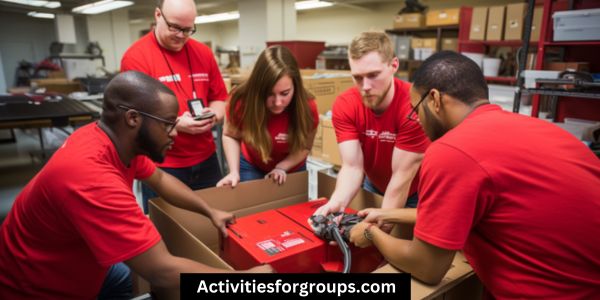Are you looking to plan group volunteer work? You can do it!
Start by establishing a goal, recruiting volunteers, delegating tasks, monitoring progress, and recognizing efforts.

With these steps, you’ll be well on your way to achieving your goal. So don’t wait – get started today and make a difference!
Establish a Goal
Before beginning to plan your group volunteer work, it’s important to establish a goal. Identify your motivations for volunteering and discuss them with your group. Be aware that everyone may have different reasons for wanting to help. Also, it’s important to define success. What does your group hope to achieve? Once you have a clear goal, you can make plans to reach it.
Make sure you have a timeline to evaluate outcomes along the way. This will help you measure your progress and make adjustments if necessary. Consider setting deadlines for completing tasks, and create a system for tracking your progress. You should also create a budget and be sure to account for costs like travel, supplies, and food.
Recruit Volunteers
Once you have established a goal for your group volunteer work, the next step is to recruit volunteers. To do this, you must first identify the needs of your project. Once you know what kind of volunteers you need, you can begin to reach out to potential volunteers. You can do this by advertising the project in your community and utilizing social media platforms. Additionally, you can reach out to local organizations, churches, and schools to help spread the word.
When recruiting volunteers, it’s important to make sure you motivate people to be part of the project. This can be done by sharing success stories of previous projects, highlighting the impact the project will have on the community, and emphasizing the importance of volunteering. Additionally, you should make sure to thank volunteers and recognize their efforts.
Finally, you should set up a system to track your progress. Make sure to record any volunteer hours, contact information, and payments. Doing this will help you keep track of the progress of your project and make sure you’re meeting your goals.
Recruiting volunteers for your group volunteer project is an important step. By identifying your needs, utilizing social media and local organizations, motivating people, and setting up a tracking system, you can make sure your project is successful.
Delegate Tasks

Now that you’ve recruited volunteers for your group volunteer project, it’s time to delegate tasks. To start, brainstorm ideas with the team to determine the roles and tasks that need to be filled. Be sure to include everyone’s opinion in the conversation and come to a consensus on the tasks to be completed.
- Create an outline of tasks and roles.
- Assign tasks to volunteers based on their skills and availability.
- Have volunteers confirm their assigned tasks.
- Set clear expectations and deadlines.
Once you have your tasks outlined and assigned, it’s important to keep track of progress. This can be done by creating a tracking system and setting up regular check-ins. You can also use a task management software to help you and your team stay organized. Make sure to provide feedback to volunteers for their progress and congratulate them on their successes.
Delegating tasks is a great way to ensure that your group volunteer project is completed in a timely manner. With proper guidance and communication, volunteers can learn how to work together to achieve their goals. Don’t forget to track progress and provide feedback to volunteers, so everyone can stay on the same page.
Monitor Progress
Building on the previous steps of delegating tasks and setting clear expectations, it’s important to monitor progress in order to ensure a successful group volunteer project. As the project progresses, it’s important to prioritize needs and allocate resources to ensure the project stays on track.
A great way to monitor progress is via a 3-column and 3-row table. The left column can list the tasks, the middle column can list progress updates, and the right column can list any changes that need to be made.
It’s also important to set up check-in points throughout the project. These check-in points should be designed to assess the team’s progress and should also allow for communication between team members. This will ensure that everyone is on the same page and that any necessary changes can be addressed quickly.
Adding a timeline to the project plan is also essential. This will help the team stay on track and will ensure that tasks are completed on schedule. It’s also important to set milestones and deadlines for the project, as this will help the team stay focused and motivated.
Finally, it’s important to provide feedback to the team. This feedback should include both positive and constructive criticism, as this will help the team stay motivated and will help the project reach its goal. This feedback should also be used to improve the team’s performance and to help the team understand what needs to be done to complete the project.
Monitoring progress is an essential part of planning group volunteer work, and by following the steps outlined above, you can ensure that the project is completed on time and with quality results.
Recognize Efforts

Regularly recognizing the efforts of the team is an important part of planning successful group volunteer work. Here are four key steps to recognizing the team’s efforts:
- Acknowledge success in the moment: Acknowledge successes in the moment by calling out the individual or team accomplishment. This will help build morale and inspire the group to continue giving their all.
- Give positive feedback: Provide positive feedback, both in the moment and following the completion of the project. Positive feedback will help the team understand what they did well, and where they can improve.
- Celebrate achievements: Celebrate the team’s achievements in a meaningful way. This could include throwing a party, organizing a team outing, or simply taking the time to thank the team for their hard work.
- Reward the team: Rewarding the team for their efforts is a great way to show appreciation. This could include giving out certificates of appreciation, providing gift cards, or other small rewards.
Recognizing the team’s efforts is essential in planning successful group volunteer work. Acknowledging success, giving positive feedback, celebrating achievements, and rewarding the team are key steps to ensuring the team feels valued for their hard work.
Frequently Asked Questions
What Is the Best Way to Encourage More Volunteers to Join the Team?
Reward those who volunteer by recognizing their contributions and providing feedback. Show appreciation and make them feel valued. This will encourage more to join the team.
What Is the Most Effective Way to Communicate Tasks to Volunteers?
The most effective way to communicate tasks to volunteers is by managing expectations and fostering communication. Let volunteers know what is expected of them and keep the lines of communication open.
How Do You Ensure Volunteers Feel Appreciated and Motivated?
Thank volunteers for their efforts, recognize their successes and reward them for results. Show your appreciation and motivate them to keep helping.
How Should Tasks Be Distributed Among Volunteers?
Gather feedback from volunteers on their strengths and interests, then delegate roles that best suit them. This will help ensure fairness and motivation.
How Do You Ensure All Volunteers Are Following the Same Plan?
You can ensure volunteers are following the same plan by developing trust and setting expectations. Communicate clearly and regularly, and ensure everyone is on the same page.
Conclusion
Planning group volunteer work can seem daunting, but it doesn’t have to be.
Establish a goal, recruit volunteers, delegate tasks, monitor progress, and recognize efforts, and you’ll be well on your way to a successful project.
With the right organization and dedication, you can make a difference!




Leave a Reply